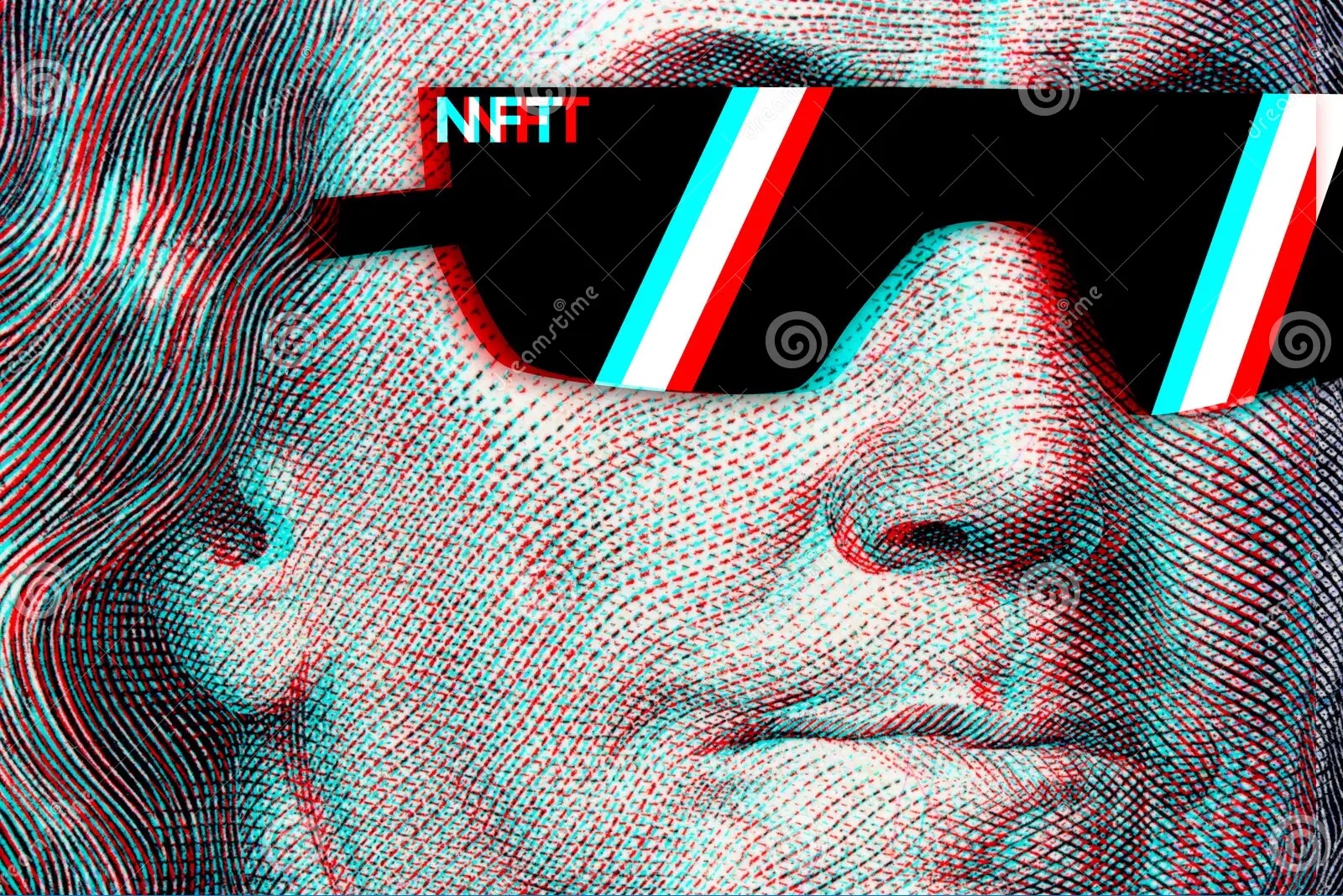NFT-glut: What was it, why did it explode and is it gone?
What is NFT?
NFT or Non-Fungible Token is in Estonian non-replaceable token. It is a digital asset with the key characteristics of uniqueness and irreplaceability. Unlike conventional on cryptocurrencies, which are interchangeable (such as Bitcoin), each NFT is unique and has individual value.
NFTs arrived in 2014, when "coloured coin" technology was added to the bitcoin blockchain. This allowed the creation of unique digital assets that were different from each other. Although the first NFT was created in 2014, it only gained wider recognition a few years later with the creation of the Ethereum blockchain and the ERC-721 standard. This standard contributed to the explosive growth of the NFT industry, enabling the creation and sale of unique digital objects such as art, trading cards and more.

Example of NFT:
Imagine you have a unique digital artwork. This work is stored on a blockchain and has a unique code that proves your ownership. This code is like a digital certificate that confirms the authenticity and value of the work. You can keep this artwork in your digital wallet, show it to others and even resell it..
From find the most popular NFTs
The difference between the original and the NFT:
In the case of traditional art, the original painting is unique and valuable, while the copy is worthless. In the digital world, however, all copies are easy to create and distribute. NFT solves this problem by creating a digital asset that is unique and authentic.
The role of blockchain technology in NFTs:
NFTs are stored in a blockchain, which is a decentralised database. This means that the data is not stored in one place, but is shared between a network of computers. This guarantees the authenticity and ownership of the NFT, as it is impossible to tamper with or modify the data.
Blockchain technology at its simplest:
Imagine that a blockchain is like a big ledger where all your transactions are stored. Each transaction is a block added to the chain. To add new transactions you need the approval of the majority of the network. This ensures the security and transparency of transactions.
To sum up:
The NFT is a unique and irreplaceable digital asset stored on a blockchain. It provides a solution to ensure the authenticity and ownership of digital assets. NFTs have the potential to change the future of digital art, music, games and more.
The rise of NFT madness
In 2021, the market for NFTs experienced explosive growth. Interest in digital assets grew rapidly and many NFTs were sold for huge sums. This frenzy attracted investors and speculators hoping to get rich quick.
Why did NFTs become popular?
Here are some of the reasons why NFTs became popular for art and other digital assets:
- Authenticity and ownership: NFTs provide a solution to ensure the authenticity and ownership of digital assets. Plokiahela technology can be used to create unique and irreplaceable assets. tokeneids representing digital objects.
- A rarity: Many NFTs are created in limited quantities, making them rare and attractive to collectors.
- Investment opportunity: Some investors see NFTs as a new investment opportunity. Many believe that the value of NFTs will increase over time, especially for rare and sought-after assets. tokenfor.
- Speculation: Many NFTs were bought for speculative purposes in the hope of selling them on at a profit.
Outstanding sales:
Some NFTs were sold in 2021 for huge sums. For example:
- Beeple's NFT "The First 5000 Days" sold for $69.3 million, making it the most expensive NFT sale at the time.
- NBA Top Shot NFTs sold for millions of dollars. For example, LeBron James' Cosmic Dunk sold for $208 000.
Failed sales:
While many NFTs were sold successfully in 2021, there were also failures. For example:
- Jack Dorsey the first tweet from NFT was sold for $2.9 million, but as of 2023, its value has dropped to around $40 000.
- The Nyan Cat NFT was sold for $590 000, but as of 2023 its value has fallen to around $30 000.
Theories on the future of NFTs
Bubble vs. revolution:
There are two opposing theories about the future of NFTs:
- Mull: Some believe that NFTs are simply a passing trend that has already peaked and is now continuing to fade. They point to a cooling market in 2022 and a fall in NFT prices as proof that this is a bubble that has burst.
- Revolution: Others see NFTs as having the potential to transform the future of digital ownership and identity. They believe that NFTs are a new technology in its infancy with great potential to grow in the future.
Arguments in support of both theories:
Mull:
- Cooling down: A sharp decline in the NFT market in 2022.
- Speculativeness: Many NFTs were bought for speculative purposes, not for their intrinsic value.
- Overrated: Critics say many NFTs are objects of speculation and their values are artificially inflated.
- Uncertainty: The NFT market is highly volatile and can fall sharply, leaving investors with huge losses.
- Environmental impact: Plokiahela technology, on which NFTs are based, is very large in terms of energy consumption, which raises environmental concerns.
Revolution:
- Revolution: NFTs have the potential to change the future of art, music, games and more.
- Investment: Large technology companies and investment funds are investing in NFTs and blockchain technology.
- Authorship and transfer of ownership: NFTs offer creators and artists a new way to take ownership of their work and prove authorship.
- New markets: NFTs enable the creation of new digital asset classes and markets, opening up unprecedented opportunities for the creative economy.
- Authenticity: NFTs help to fight counterfeiting, ensuring the authenticity and provenance of digital assets.
Lost value
One study the 95% from all NFT collections is now completely worthless. According to this study, more than 23 million people own worthless NFTs, which means that their investments have failed.
NFTs as tools for money laundering
There is also a theory that NFTs have potentially been used for money laundering. The anonymous nature of the transactions and the speculative nature of NFTs may make them an attractive tool for money launderers.
Why this theory is possible:
- NFT transactions are anonymous
- The value of NFTs is difficult to assess objectively
- NFTs can be sold quickly and easily
Is this theory proven?:
However, there is not yet enough evidence to prove this theory conclusively. Some studies have shown that NFTs have been used for money laundering, but these studies are limited in scope.
Weak spots:
- It is difficult to distinguish legitimate NFT transactions from money laundering transactions.
- There are no clear rules and regulations to regulate the market for NFTs.
To sum up:
The future of NFTs is uncertain. It is possible that this is a passing trend that will fade away. It is also possible that it is a new technology that will change the world. Only time will tell which of these theories is correct.
Use of NFTs in real life
In addition to speculative buying and selling, NFTs also have real uses in a variety of areas. Here are some examples:
Ticket sales
NFTs can be used to sell tickets for events such as concerts, sports matches and conferences. This helps to avoid counterfeit tickets and the black market. Ticketmaster, for example, has started to use NFTs to sell tickets for certain events.
Providing exclusive content
NFTs can be used to provide exclusive content such as music, videos and artwork. This gives artists and creators new ways to monetise their work and engage with fans. For example, musician Grimes sold his album "Miss Anthropocene" as an NFT.
Creating a digital identity
NFTs can be used to create a digital identity. This identity can be used on different platforms and gives people more control over their data. For example, Enjin Coin is a platform that offers NFTs to create digital identities.
The games industry
NFTs have great potential in the games industry. They can be used to represent in-game items that are unique and irreplaceable. This gives players new opportunities to personalise their gaming experience and own their assets. For example, CryptoKitties is a game where players can collect, breed and sell virtual cats as NFTs.
Metaverse
NFTs have great potential in the metaverse. They can be used to represent virtual assets such as lands, avatars and objects. This gives people new ways to interact in their virtual lives and to own their assets.
Summary
NFTs are digital assets that are unique and irreplaceable. They can be used in a wide range of fields, such as art, music, games and metaverse. NFTs have the potential to change the way we interact with digital assets.
It is too early to say what the future holds for NFTs. It is possible that it is a passing trend that will fade away. It is also possible that it is a new technology that will change the world. Only time will tell which of these theories is correct.
Whatever the future of NFTs, it is a technology worth keeping an eye on. It could potentially change the way we own, create and share digital assets.
